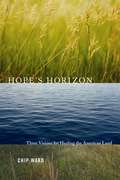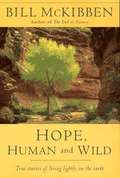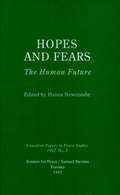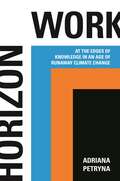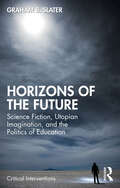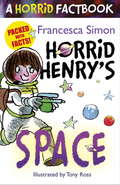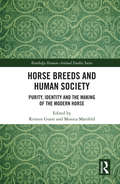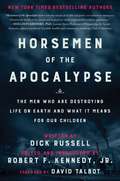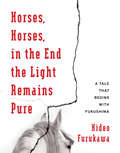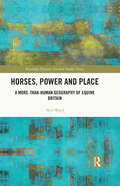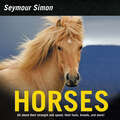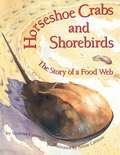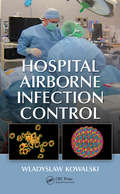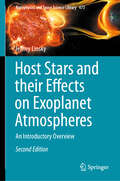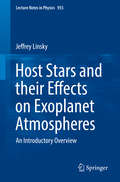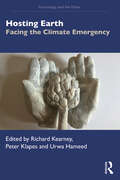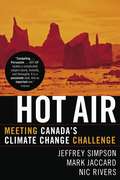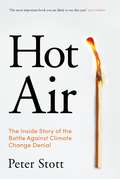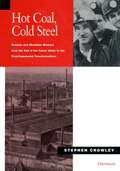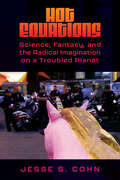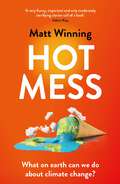- Table View
- List View
Hope's Horizon: Three Visions For Healing The American Land
by Chip WardAt a time of widespread environmental pessimism, Hope's Horizon goes on an inspirational offensive. In this entertaining and thought-provoking book, author Chip Ward tells of his travels among a new generation of activists who are moving beyond defensive environmental struggles and advocating pioneering, proactive strategies for healing the land. Chip Ward's three-year odyssey took him behind the scenes of efforts to reconnect fragmented habitats and "re-wild" the North American continent; the campaign to drain Lake Powell and restore Glen Canyon to its natural state; and the struggle to keep nuclear waste off Western Shoshone ancestral lands and, ultimately, to abolish all nuclear power and weapons. These movements, and the practical visionaries leading them, challenge readers with a new paradigm in which land is used in a spirit of collaboration with natural systems rather than domination of them. Broad in its sweep, Hope's Horizon uses its topical subjects as springboards for exploring how we can redefine our place in the world while restoring damaged habitats, replenishing lost diversity, and abandoning harmful technologies. Lively, literate, and free of the grimness that characterizes so much environmental writing, Hope's Horizon will change the way readers see the world. It makes complicated concepts and issues accessible, and wild ideas compelling. And while the book's starting point is a hard-nosed indictment of humanity's failed stewardship of the earth, the stories that follow tell of catalytic optimism and ecological wisdom in the face of self-destructive habit and blind pride.
Hope, Human and Wild: True Stories of Living Lightly on the Earth
by Bill MckibbenIn lyrical, penetrating essays, Bill McKibben offers an optimistic response to his bestselling "The End of Nature", focusing on successful community ventures to preserve the wilderness and reverse environmental damage. From his home in the Adirondack Mountains to a city in Brazil and a state in India, McKibben searches for realistic models for the future of the planet.
Hopes and Fears: The Human Future (Canadian Papers in Peace Studies #2)
by Hanna NewcombeIt has been said many times that the human future is clouded by multiple and mutually interacting problems. While in the 19th century we had the luxury of believing in almost automatic progress - an "onward and upward" assumption - that belief has been shattered by two world wars, more than 150 smaller ones, the invention of weapons of mass destruction, increasing degradation of the environment, both by pollution and resource exhaustion (i.e. adding "bads" and subtracting "goods" from our natural endowment), a horrendous (and increasing) gap between rich and poor within and between nations, explosions of racism and chauvinistic nationalism, increasing use of torture as a police method, totalitarian regimes, repeated episodes of genocide … not a picture of progress toward a better world. And yet, we have not quite lost faith in the human potential for more beneficial and harmonious development.
Hopf Algebras and Quantum Groups (Lecture Notes in Pure and Applied Mathematics #Vol. 209)
by Freddy Van Oystaeyen Stefaan CaenepeelThis volume is based on the proceedings of the Hopf-Algebras and Quantum Groups conference at the Free University of Brussels, Belgium. It presents state-of-the-art papers - selected from over 65 participants representing nearly 20 countries and more than 45 lectures - on the theory of Hopf algebras, including multiplier Hopf algebras and quantum g
Hopf Algebras in Noncommutative Geometry and Physics (Lecture Notes in Pure and Applied Mathematics #Vol. 239)
by Freddy Van Oystaeyen Stefaan CaenepeelThis comprehensive reference summarizes the proceedings and keynote presentations from a recent conference held in Brussels, Belgium. Offering 1155 display equations, this volume contains original research and survey papers as well as contributions from world-renowned algebraists. It focuses on new results in classical Hopf algebras as well as the
Horizon Work: At the Edges of Knowledge in an Age of Runaway Climate Change
by Adriana PetrynaA new way of thinking about the climate crisis as an exercise in delimiting knowable, and habitable, worldsAs carbon dioxide emissions continue to rise, Earth’s fragile ecosystems are growing increasingly unstable and unpredictable. Horizon Work explores how climate change is disrupting our fundamental ability to project how the environment will act over time, and how these rapidly faltering predictions are colliding with the dangerous new realities of emergency response.Anthropologist Adriana Petryna examines the climate crisis through the lens of “horizoning,” a mode of reckoning that considers unnatural disasters against a horizon of expectation in which people and societies can act. She talks to wildfire scientists who, amid chaotic fire seasons and shifting fire behaviors, are revising predictive models calibrated to conditions that no longer exist. Petryna tells the stories of wildland firefighters who could once rely on memory of previous fires to gauge the behaviors of the next. Trust in patterns has become an occupational hazard. Sometimes, the very concept of projection becomes untenable. Yet if all we see is doom, we will overlook something crucial about the scientific and ethical labor needed to hold back climate chaos. Here is where the work of horizoning begins.From experiments probing our planetary points of no return to disaster ecologies where the stark realities of climate change are being confronted, Horizon Work reveals how this new way of thinking has the power to reverse harmful legacies while turning voids where projection falters into spaces of collective action and recoverable futures.
Horizons of the Future: Science Fiction, Utopian Imagination, and the Politics of Education (Critical Interventions)
by Graham B. SlaterHorizons of the Future: Science Fiction, Utopian Imagination, and the Politics of Education examines the relationship between science fiction, education, and social change in the 21st century.Global capitalism is ecologically unsustainable and ethically indefensible; time is running out to alter the course of history if humanity is to have hope of a livable future beyond the next century. However, alternatives are possible, offering much more equality, care, justice, joy, and hope than the established order. Popular culture and schools are key sites of struggles to imagine such alternatives. Drawing on critical theory, cultural studies, and sociology, Slater articulates the promising connection between science fiction and the future of education. He offers cutting-edge engagement with themes, perspectives, and modes of imagination in science fiction that can be mobilized politically and pedagogically to envision and enact critical forms of education that cultivate new utopian ways of relating to self, society, and the future.This thought-provoking book will be of interest to scholars and students in the social sciences and education.
Horrid Henry's Space: A Horrid Factbook (Horrid Henry #1)
by Francesca SimonFrom multi-million-copy selling author Francesca Simon, and David Walliams' illustrator, Tony Ross, comes the intriguing tenth Horrid Henry's Factbook about all things outer space. What sound does the sun make? How long would it take to travel there in a car? And how do astronauts go to the toilet? Bursting with out-of-this-world facts and cosmic trivia, this is the perfect guide to everything a Horrid Henry fan has ever wanted to know about outer space, ideal for budding scientists and astronauts and Henry fanatics alike. Readers can surprise and awe their family and friends with amazing new knowledge!
Horse Breeds and Human Society: Purity, Identity and the Making of the Modern Horse (Routledge Human-Animal Studies Series)
by Monica Mattfeld Kristen GuestThis book demonstrates how horse breeding is entwined with human societies and identities. It explores issues of lineage, purity, and status by exploring interconnections between animals and humans. The quest for purity in equine breed reflects and evolves alongside human subjectivity shaped by categories of race, gender, class, region, and nation. Focusing on various horse breeds, from the Chincoteague Pony to Brazilian Crioulo and the Arabian horse, each chapter in this collection considers how human and animal identities are shaped by practices of breeding and categorizing domesticated animals. Bringing together different historical, geographical, and disciplinary perspectives, this book will appeal to academics, as well as undergraduate and postgraduate students, in the fields of human-animal studies, sociology, environmental studies, cultural studies, history, and literature.
Horsemen of the Apocalypse: The Men Who Are Destroying the Planet—And How They Explain Themselves to Their Own Children
by David Talbot Dick Russell Robert F. Kennedy Jr.The science is overwhelming; the facts are in. The planet is heating up at an alarming rate and the results are everywhere to be seen. Yet, as time runs out, climate progress is blocked by the men who are profiting from the burning of the planet: energy moguls like the Koch brothers and Exxon Mobil CEO Rex Tillerson. Powerful politicians like Senators Mitch McConnell and Jim Inhofe, who receive massive contributions from the oil and coal industries. Most of these men are too intelligent to truly believe that climate change is not a growing crisis. And yet they have put their profits and careers ahead of the health and welfare of the world’s population?and even their own children and grandchildren. How do they explain themselves to their offspring, to the next generations that must deal with the environmental havoc that these men have wreaked? Horsemen of the Apocalypse takes a personal look at this global crisis, literally bringing it home.
Horses, Horses, in the End the Light Remains Pure: A Tale That Begins with Fukushima (Weatherhead Books on Asia)
by Hideo Furukawa"As we passed from the city center into the Fukushima suburbs I surveyed the landscape for surgical face masks. I wanted to see in what ratios people were wearing such masks. I was trying to determine, consciously and unconsciously, what people do in response. So, among people walking along the roadway, and people on motorbikes, I saw no one with masks. Even among the official crossing guards outfitted with yellow flags and banners, none. All showed bright and calm. What was I hoping for exactly? The guilty conscience again. But then it was time for school to start. We began to see groups of kids on their way to school. They were wearing masks."Horses, Horses, in the End the Light Remains Pure is a multifaceted literary response to the earthquake, tsunami, and nuclear meltdown that devastated northeast Japan on March 11, 2011. The novel is narrated by Hideo Furukawa, who travels back to his childhood home near Fukushima after 3/11 to reconnect with a place that is now doubly alien. His ruminations conjure the region's storied past, particularly its thousand-year history of horses, humans, and the struggle with a rugged terrain. Standing in the morning light, these horses also tell their stories, heightening the sense of liberation, chaos, and loss that accompanies Furukawa's rich recollections. A fusion of fiction, history, and memoir, this book plays with form and feeling in ways reminiscent of Vladimir Nabokov's Speak, Memory and W. G. Sebald's The Rings of Saturn yet draws its own, unforgettable portrait of personal and cultural dislocation.
Horses, Power and Place: A More-Than-Human Geography of Equine Britain (Routledge Human-Animal Studies Series)
by Neil WardHorses, Power and Place explores the evolution of humanity’s relationship with horses, from early domestication through to the use of the horse as a draught animal, an agricultural, industrial and military asset, and an animal of sport and leisure. Taking an historical approach, and using Britain as a case study, this is the first book-length exploration of the horse in the more-than-human geography of a nation. It traces the role and implications of horse-based mobility for the evolution of settlement structure, urban morphology and the rural landscape. It maps the growth and various uses of horses to the point of ‘peak horse’ in the early twentieth century before considering the contemporary place of the horse in twenty-first century economy and society. It assesses the role of the horse in the formation of places within Britain and in the formation of the nation. The book reflects on the implications of this historical and contemporary equine geography for animal geographies and animal studies. It argues for the study of animals in general in how places are made, not just by humans. Written in a clear and accessible style, this book will be essential reading for students and scholars of animal geography and animal studies more widely.
Horses: Revised Edition
by Seymour SimonFrom award-winning science writer Seymour Simon comes a completely revised and updated edition of Horses, with brand-new full-color photographs. This nonfiction picture book is an excellent choice to share during homeschooling, in particular for children ages 6 to 8. It’s a fun way to learn to read and as a supplement for activity books for children.Readers will learn how horses came to be domesticated, how to distinguish different breeds, the important roles horses have served throughout history, and more. From stallions and mares and Clydesdales to Palominos, this is sure to be a hit with horse lovers and animal lovers everywhere!This updated edition includes:• author’s note• stunning full-color photographs• glossary• index• additional reading sourcesSupports the Common Core Learning Standards, Next Generation Science Standards and the Science, Technology, Engineering, and Math (STEM) standards.
Horseshoe Crabs And Shorebirds: The Story Of A Foodweb
by Victoria Crenson Annie CannonEach spring, hundreds of thousands of horseshoe crabs crawl from the bottom of Delaware Bay to lay billions of pearly green eggs on the beaches. Their salty eggs provide a feast for scavenging coastal animals, but billions more are eaten by the flocks of shorebirds that stop to rest and feed each spring after flying north from their homes in South America. In recent years the horseshoe crab population has dwindled. In turn, the number of shorebirds that fly north each year has grown smaller. Illuminated with warm, detailed watercolors, Horseshoe Crabs and Shorebirds demonstrates the delicate relationship between these animals and is an excellent resource for ecology lessons, as well as a dramatic storybook for sharing.
Hospital Airborne Infection Control
by Wladyslaw KowalskiAlthough nosocomial, or hospital-acquired, infections have been well cataloged and are fairly well understood, traditional solutions have failed to completely eliminate the problem. Even the most modern hospitals find themselves stymied by the persistence of these pathogens in hospital wards and operating rooms. The degree to which most of these in
Hospitality, Home and Life in the Platform Economies of Tourism
by Maartje RoelofsenThis book explores how digital platforms in the realm of tourism and hospitality have shaped social and material worlds. Based on extensive ethnographic fieldwork with hosts and guests, the book analyses the impacts of platforms on the scale of the city, the home, and the everyday life of individuals. The book first situates platforms within the broader history of digital developments in tourism and questions what is essentially new about these socio-technical formations? The following chapters demonstrate how platforms have affected urban housing, challenged the tourism sector, and transformed understandings of hospitality and home. This is illustrated through a case-study of Airbnb’s development and impact in Sofia, Bulgaria. The final chapters of the book reflect on the political dimensions of datafication processes and digital systems of measurement that underpin the platform’s workings, showing how the platform economies of tourism benefit their users in highly uneven ways.
Host Stars and their Effects on Exoplanet Atmospheres: An Introductory Overview (Astrophysics and Space Science Library #473)
by Jeffrey LinskyThis comprehensive introductory overview describes the emission of radiation (X-rays to radio) and the winds of host stars and how they control the past, present, and future evolution of an exoplanet. The book focuses on topics that are critically important for understanding exoplanet atmospheres but are often posed without a comprehensive and detailed understanding of the host star and its effects on the exoplanet. Although both stars and exoplanets are usually studied in isolation, in this book they are treated as an integrated system. Whether or not an exoplanet can retain its atmosphere and the chemical composition of the atmosphere depends critically on the strength, time dependence, and spectral energy distribution of the host star's radiation, flares, coronal mass ejections, and wind, which are described in detail in the book. The book describes the roles played by magnetic fields in the coronae and chromospheres of host stars that tie together stellar active phenomena with major effects on exoplanet atmospheres. In the era of JWST and very sensitive ground- and space-based instruments, a critical topic is the noise imposed on radial velocity measurements and transit photometry and spectroscopy by the host star's activity and variability that fundamentally limit our understanding of exoplanet properties. This topic is addressed in detail in the book. This book is written primarily for graduate students and researchers who are studying exoplanet atmospheres and habitability, but who may not have a background in the physics and phenomenology of host stars. The book could serve as a reference book for graduate level classes on exoplanets. Nonspecialists with a scientific background should also find this text a valuable resource for understanding the critical issues of contemporary exoplanet research. This new edition of “Host Stars and their Effects on Exoplanet Atmospheres" is a major revision of the existing book in the following ways: It includes a new discussion of how stellar noise fundamentally limits our understanding of exoplanet atmospheres It demonstrates in detail how stellar activity acts as fundamental driver of exoplanet atmosphere evolution It provides an outlook on how the field of exoplanet atmospheres and bio-astrophysics is being driven by powerful new telescopes and instruments It extensively updates many chapters, in particular concerning host star extreme- and far-ultraviolet emission, stellar winds, stellar surface structures, the effects of space weather on exoplanets, and provides a realistic evaluation of habitability taking into account the evolution of host star activity.
Host Stars and their Effects on Exoplanet Atmospheres: An Introductory Overview (Lecture Notes in Physics #955)
by Jeffrey LinskyLike planets in our solar system, exoplanets form, evolve, and interact with their host stars in many ways. As exoplanets acquire material and grow to the final size, their atmospheres are subjected to intense UV and X-radiation and high-energy particle bombardment from the young host star. Whether a planet can retain its atmosphere and the conditions for significant mass loss both depend upon the strength of the host star's high-energy radiation and wind, the distance of the exoplanet from its host star, the gravitational potential of the exoplanet, and the initial chemical composition of the exoplanet atmosphere. This introductory overview describes the physical processes responsible for the emission of radiation and acceleration of winds of host stars that together control the environment of an exoplanet, focusing on topics that are critically important for understanding exoplanetary atmospheres but are usually not posed from the perspective of host stars. Accordingly, both host stars and exoplanets are not studied in isolation but are treated as integrated systems. Stellar magnetic fields, which are the energy source for activity phenomena including high-energy radiation and winds, play a critical role in determining whether exoplanets are habitable. This text is primarily for researchers and graduate students who are studying exoplanet atmospheres and habitability, but who may not have a background in the physics and phenomenology of host stars that provide the environment in which exoplanets evolve. It provides a comprehensive overview of this broad topic rather than going deeply into many technical aspects but includes a large list of references to guide those interested in pursuing these questions. Nonspecialists with a scientific background should also find this text a valuable resource for understanding the critical issues of contemporary exoplanet research.
Hosting Earth: Facing the Climate Emergency (Psychology and the Other)
by Richard Kearney Peter Klapes Urwa HameedHosting Earth is a timely and much-needed volume in the emerging literature of environmental philosophy, drawing upon art, science, and politics to explore alternatives to the traditional domination of nature by humans.Featuring a dialogue with Mary Robinson (former UN High Commissioner for Human Rights and former President of Ireland), which addresses the current climate emergency, this book engages the question of ecological hospitality: what does it mean to be guests of the earth as well as hosts? It includes chapters by cutting-edge scholars in the philosophy of nature, as well as artists, scientists, psychologists, and theologians. The contributors discuss proposals for a new "Poetics of the Earth," opening horizons beyond our perilous Anthropocene to a new Symbiocene of mutual collaboration between human and non-human species.Focusing on the central role that the human psyche plays in answering our current ecological emergency, Hosting Earth is for anybody invested in the future of our planet and how psychological, psychoanalytic, and philosophical thought can reorient the current conversation about ecology.
Hot Air: Meeting Canada's Climate Change Challenge
by Jeffrey Simpson Nic Rivers Mark JaccardHere's a clear, believable book for Canadians concerned about our situation -- and it offers a solution. It's a brilliant mix. To "Canada's best mind on the environment," Mark Jaccard, who won the 2006 Donner Prize for an academic book in this area, you add Nic Rivers, a researcher who works with him at Simon Fraser University. Then you add Jeffrey Simpson, the highly respected Globe and Mail columnist, to punch the message home in a clear, hard-hitting way. The result is a unique book.Most other books on energy and climate change are: (a) terrifying or (b) academic or (c) quirky, advocating a single, neat solution like solar or wind power. This book is different. It starts with an alarming description of the climate threat to our country. Then it shifts to an alarming description of how Canadians have been betrayed by their politicians ("We're working on it!"), their industrialists ("Things aren't that bad, really, and voluntary guidelines will be good enough."), and even their environmentalists ("Energy efficiency can be profitable, and people can change their lifestyles!") All of this, of course, reinforces the myths that forceful policies are not needed. Hot Air then lays out in convincing and easily understandable terms the few simple policies that Canada must adopt right away in order to significantly reduce greenhouse gas emissions over the next few decades. It even shows how these policies can be designed to have minimal negative effects. With evidence from other countries that are successfully addressing climate change, Hot Air shows why these are the only policies that will work -- and why this is a matter of life and death for all of us.
Hot Air: The Inside Story of the Battle Against Climate Change Denial
by Peter StottThe shocking inside story of the fight to halt climate change over the past twenty-five years by a world-renowned scientist.Ours is the age of global warming. Rising sea levels, extreme weather, forest fires. Dire warnings are everywhere, so why has it taken so long for the crisis to be recognised?Here, for the first time, climate scientist Peter Stott reveals the bitter fight to get international recognition for what, among scientists, has been known for decades: human activity causes climate change. Across continents and against the efforts of sceptical governments, prominent climate change deniers and shadowy lobbyists, Hot Air is the urgent story of how the science was developed, how it has been repeatedly sabotaged and why humanity hasn't a second to spare in the fight to halt climate change.
Hot Carbon: Carbon-14 and a Revolution in Science
by Professor John F. MarraThere are few fields of science that carbon-14 has not touched. A radioactive isotope of carbon, it stands out for its unusually long half-life. Best known for its application to estimating the age of artifacts—carbon dating—carbon-14 helped reveal new chronologies of human civilization and geological time. Everything containing carbon, the basis of all life, could be placed in time according to the clock of radioactive decay, with research applications ranging from archeology to oceanography to climatology.In Hot Carbon, John F. Marra tells the untold story of this scientific revolution. He weaves together the workings of the many disciplines that employ carbon-14 with gripping tales of the individuals who pioneered its possibilities. He describes the concrete applications of carbon-14 to the study of all the stuff of life on earth, from climate science’s understanding of change over time to his own work on oceanic photosynthesis with microscopic phytoplankton. Marra’s engaging narrative encompasses nuclear testing, the peopling of the Americas, elephant poaching, and the flax plants used for the linen in the Shroud of Turin. Combining colorful narrative prose with accessible explanations of fundamental science, Hot Carbon is a thought-provoking exploration of how the power of carbon-14 informs our relationship to the past.
Hot Coal, Cold Steel: Russian and Ukrainian Workers from the End of the Soviet Union to the Post-communist Transformations
by Stephen CrowleyWell after the disintegration of the Communist Party and the Soviet state--and through several years of economic collapse--industrial workers in almost every sector of the former Soviet Union have remained quiescent and the same ineffective and unpopular trade unions still hold a virtual monopoly on worker's representation. Why? While many argue that labor is a central variable in the development of economic and political systems, little is known about workers in the states of the former Soviet Union since the fall of Communism. In a comparative study of two groups of industrial workers--the coal miners and steelworkers--at the end of the Soviet era, Stephen Crowley sheds light on where these workers have been and where they are going. Coal miners in the final years of the Soviet Union effectively organized and led strikes which supported the end of Communism, even though their heavy subsidies would be threatened by capitalism. Steel workers, in contrast, did not effectively organize and strike. This pattern has continued under the new governments, with the coal miners effectively organized and seeking protection from the worst consequences of marketization, while the steel workers remain weakly organized despite deteriorating economic conditions. Based on extensive on-site research including interviews with miners and steelworkers, labor leaders and plant managers, Crowley develops a detailed picture of the conditions under which workers organize. His findings have application beyond the conditions of post-Communist Russia and Ukraine to other societies undergoing fundamental change.
Hot Equations: Science, Fantasy, and the Radical Imagination on a Troubled Planet
by Jesse S. CohnInspired by the new diversity of science fiction, fantasy, and horror in the twenty-first century, Hot Equations: Science, Fantasy, and the Radical Imagination on a Troubled Planet confronts the kinds of literary and political “realism” that continue to suppress the radical imagination. Alluding both to the ongoing climate catastrophe and to Tom Godwin’s “The Cold Equations”—that famous touchstone of “hard science fiction”—Hot Equations reads the crises of our "post-normal" moment via works that increasingly subvert genre containment and spill out into the public sphere. Drawing on archives and contemporary theory, author Jesse S. Cohn argues that these imaginative works of science fiction, fantasy, and horror strike at the very foundations of modernity, calling its basic assumptions into question. They threaten the modern order with a simultaneously terrible and promising anarchy, pointing to ways beyond the present medical, ecological, and political crises of pandemic, climate change, and rising global fascism. Examining books ranging from well-known titles like The Hunger Games and The Caves of Steel to newer works such as Under the Pendulum Sun and The Stone Sky, Cohn investigates the ways in which science fiction, fantasy, and horror address contemporary politics, social issues, and more. The “cold equations” that established normal life in the modern world may be in shambles, Cohn suggests, but a New Black Fantastic makes it possible for the radical imagination to glimpse viable possibilities on the other side of crisis.
Hot Mess: What on earth can we do about climate change?
by Matt Winning'A very funny, important and only moderately terrifying clarion call of a book' - Adam Kay'HOT MESS provides loads of laughs about "the climate situation" and will position you at the right point between fear and determination' - Mark Watson 'Hilarious, informative and worrying in equal measure. And that's just the bits about having a baby' - Josie LongFor fans of Randall Munro's WHAT IF? Matt Parker's HUMBLE PI and anyone looking for practical tips on how to stop the end of the world!Dr Matt Winning is a stand-up comedian and environmental economist with a PHD in climate change policy, which means he's the sort of doctor who will rush to your side if you fall ill on a plane, but only to berate you for flying. We are currently facing a global climate emergency. You've probably noticed. But why does the end of the world need to be so depressing? HOT MESS aims to both lighten the mood and enlighten readers on climate change. This is a book for people who care about climate change but aren't doing much about it, helping readers understand what the main causes of climate change are, what changes are needed, and what they can (and cannot) do about it. But, most importantly, it is book that'll help people find the comedy in climate change, because if we can do that, well, we can do bloody anything.'Climate change is no laughing matter - oh yes it is - with Matt Winning's superb, hilarious, side-splitting book that makes you take a whole new look at the climate crisis, surviving having children and life in general' - Mark Maslin, author of How to Save Our Planet'The first book about climate change that made me laugh out loud. If you've been too freaked out to subject yourself to the climate crisis, Hot Mess is the kick in the pants you need to start making yourself useful.' - Prof. Kimberly Nicholas, author of Under the Sky We Make: How to Be Human in a Warming World
